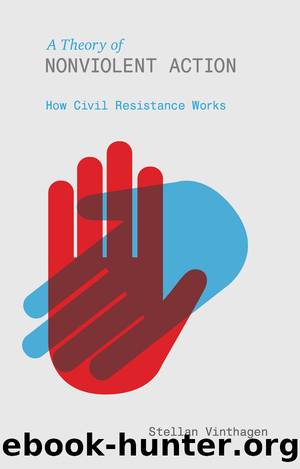A Theory of Nonviolent Action by Stellan Vinthagen

Author:Stellan Vinthagen
Language: eng
Format: epub
Publisher: Zed Books
Published: 2015-07-14T16:00:00+00:00
Emotional blackmail If activists perceive their own truth as the Truth, seek short-sighted success and see suffering as a key to victory, there is a risk that a confusion between suffering and truth will characterise the struggle. By using their voluntary suffering, activists can create such strong emotional reactions that they manage to get others to subordinate themselves to their demands. In such actions, there is a risk that emotional blackmail will arise. Most people are affected badly by others’ suffering, especially if they are in some way made responsible. During the Vietnam War, there were activists who, in their resistance to the war, committed suicide by setting themselves on fire in public places (‘self-immolation’).58 Today, over 100 Tibetans have used self-immolation as protest against the Chinese occupation. Gandhi diligently fasted to enlighten his own nonviolent activists, his family and other Indian groups in cases where he thought they were oppressive and where he wanted to change their behaviour.59 His fasts were often indefinite, which meant that they entailed an obvious risk to his life. One can legitimately point out that fasting has a different meaning in Indian culture, where Gandhi’s fasts were interpreted as his penance for his own and others’ moral mistakes (‘fasting for purification’).60 But, based on other good reasons, a fast to the death can be perceived as essentially the same thing as a hunger strike and thus an attempt at blackmail, at least in the West.61 This is the way most hunger strikes are applied by prisoners. Prisoners fall into this blackmailing most probably due to their lack of normal political rights and freedoms, which makes it hard to articulate claims or protest against injustices in any other way. But others also apply this sort of pressure through suffering. In 1999, an British animal rights activist fasted for so long that he came close to a life-threatening coma. His fast was linked to concrete demands made in relation to the British government’s animal protection policy. In all likelihood, politically motivated fasting can even be depicted as a moral problem in India, at least the indefinite version, something that Gandhi himself noted.62 A creative nonviolent resistance uses a number of different possibilities for exposing the type of painful suffering – what Erik Eriksson calls ‘demonstrative self-suffering’ – that enables an audience to react. And when that suffering becomes so intrusive that those who are made morally responsible cannot ignore it, then concessions are forced from them.63
Nonviolent activists who want to creatively use the risk of suffering in their struggle also need to try to avoid their suffering becoming a new obstacle for empathy, trust and emotional bridge building. Therefore, they have to avoid making their struggle into blackmail.
Download
This site does not store any files on its server. We only index and link to content provided by other sites. Please contact the content providers to delete copyright contents if any and email us, we'll remove relevant links or contents immediately.
Cecilia; Or, Memoirs of an Heiress — Volume 1 by Fanny Burney(32029)
Cecilia; Or, Memoirs of an Heiress — Volume 3 by Fanny Burney(31441)
Cecilia; Or, Memoirs of an Heiress — Volume 2 by Fanny Burney(31391)
The Great Music City by Andrea Baker(30762)
We're Going to Need More Wine by Gabrielle Union(18613)
All the Missing Girls by Megan Miranda(14636)
Pimp by Iceberg Slim(13757)
Bombshells: Glamour Girls of a Lifetime by Sullivan Steve(13670)
Fifty Shades Freed by E L James(12892)
Talking to Strangers by Malcolm Gladwell(12836)
Norse Mythology by Gaiman Neil(12796)
For the Love of Europe by Rick Steves(11343)
Crazy Rich Asians by Kevin Kwan(8868)
Mindhunter: Inside the FBI's Elite Serial Crime Unit by John E. Douglas & Mark Olshaker(8673)
The Lost Art of Listening by Michael P. Nichols(7142)
Enlightenment Now: The Case for Reason, Science, Humanism, and Progress by Steven Pinker(6857)
The Four Agreements by Don Miguel Ruiz(6298)
Bad Blood by John Carreyrou(6260)
Weapons of Math Destruction by Cathy O'Neil(5805)
